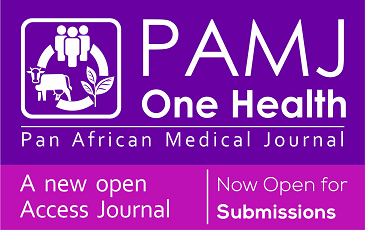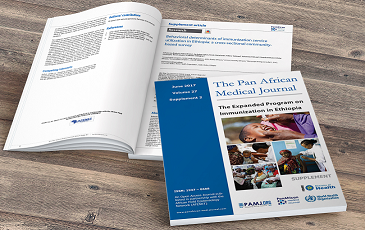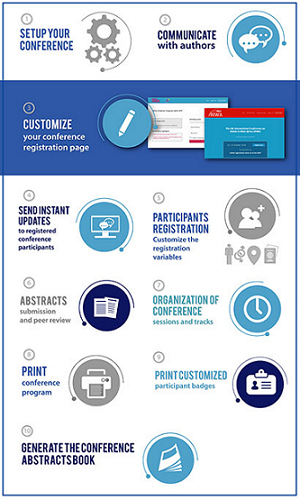Mental distress among university students in Ethiopia: a cross sectional survey
Yadeta Dessie1, Jemal Ebrahim2,&, Tadesse Awoke3
1Deparement of Public Health, Colleges of Health and Medical Sciences, Haramaya University,Harar, Ethiopia, 2Department of Psychiatry, Colleges of Health and Medical Sciences, Haramaya University, Harar, Ethiopia, 3Department of Epidemiology and Biostatistics, Institute of Public Health, College of Medicine and Health Science, University of Gondar, Gondar, Ethiopia
&Corresponding author
Jemal Ebrahim, Department of Psychiatry, Colleges of Health and Medical Sciences, Haramaya University, Harar, Ethiopia
Introduction: Mental distress is becoming a common health problem among university students .There is limited information in this regard in Ethiopia. This study was aimed to determine the prevalence and associated factors of mental distress among students in Adama University.
Methods: A cross-sectional study was conducted in March2011. Four hundred and thirteen students were participated in the study. Simple random sampling technique was applied to select the study participants. Self-Reporting Questionnaire-20(SRQ-20) was used to assess the mental distress. Respondents who had a score of eleven and above on the SRQ-20 were considered as mentally distressed.
Results: The prevalence of mental distress was 21.6%. Family history of mental illness (AOR=2.30, 95%CI: 1.10 - 4.81), frequent conflicts with fellows (AOR=2.26, 95%CI: 1.10 - 4.85), Khat (Catha Edulis) chewing (AOR=2.23, 95% CI: 1.14 - 4.35) and not attending religious program regularly were factors associated with mental distress. Being in second year of their education less likely associated (AOR=0.41, 95%CI: 0.18 - 0.91) with mental distress.
Conclusion: About one fifth of the students were found to be mentally distressed. Designing prevention sand treatments programs addressing the identified factors is important.
Mental distress is a mental health problem which manifests with different levels of depressive, anxiety, panic or somatic symptoms.It also presents with confused emotions, hallucination and related symptoms without actually being ill in a medical sense [1,2].This problem has a direct and indirect effects on the individual's psychology, social functioning and affects many aspect of life including relationships, work and health [3, 4].
Significant proportion of the world population is affected by mental distress of which tertiary education students are the once [5-8].Studies revealed that more than half of students in different countries like Singapore and United States of America (USA) had experienced emotional distress [9,10]. In the same aspect, 41.9% of students in Malaysia and 53.0% in Australian reported to have psychological distress [11,12].
Various factors were reported to be associated with the development of mental distress among university students. Separation from pre-existing social support, frustration with academic challenges, social problems, and threats due to high expectations from parents; teachers were reported attributes of mental distress which could present variably in different contexts [13-18].
In Ethiopia,mental disorders was reported to account for 11% of the total burden of diseases [19].Though limited and inconclusive, a mental distress prevalence of 32.6% to 49.1%was reported among university students in Ethiopia [20, 21].Despite mental health problem was included in national health policy of Ethiopia, interventions against the problem are limited. The main reason is the lack of data on the extent of the problem [22].This study was aimed to determine the prevalence of mental distress and identify the contributing factors among students in Adama University, Ethiopia.
Study Setting
This study was a cross-sectional survey conducted among undergraduate students of Adama University; Eastern Ethiopia. It was carried out from March 7-30; 2011. During the study period, the university had more than nine thousand regular undergraduate students of whom twenty percent were females. The study sample size was determined by a single population proportion formula with the assumptions of 95% level of confidence, 5% margin of error, prevalence of metal distress 49% which was taken from previous study conducted in the country [20] and an added15% non-response rate. With this calculation, the final sample size was 442. Simple random sampling technique was applied to select the study subjects using the list of students from the university office of registrar as a sampling frame.
Data collection
A self-administered structured questionnaire was used to collect the data. The questionnaire was derived from different literatures that included the socio-demographic characteristics, history of substance use, social issues related questions and questions addressing mental distress called Self-Reporting Questionnaire-20(SRQ-20). The questionnaire was first prepared in English and then translated to Amharic for data collection. The level of mental distress was measured using SRQ-20 items (with a 30 days recall period), which had been used previously for screening of common mental problems [23,24]. The tool (SRQ'20 items) reflects the multidimensional nature of mental disorders. It includes somatic factors, depressive/anxiety symptoms, and cognitive/decreased energy factor. The tool was validated and used in the country [25]. In this study, a cut of point of11 and above was taken to classify to mentally distress which was also used previously [26].
Data analysis
The data were entered into Epi-Info version 3.5.3 and transferred to SPSS (V16.0) for analysis. For testing the statistical significance, odds ratio with 95% Confidence Level was calculated for each independent variable against the dependent variable using the bivariate logistic regression. Multivariable logistic regression analysis was performed for those variable shown p-value of less than or equal to 0.05 in the bivariate analysis to control for the confounders and identify the independent factors. A p-value less than or equal 0.05 was used to declare the presence statistical significance.
Ethical considerations
Ethical clearance was obtained from the Institutional Research Ethics Review Committee (IRERC) of University of Gonder. A letter introducing the objective of the study, and maintaining the confidentiality was attached as the cover page of the questionnaire. Participants were consented for participation in the study. The right to refuse was clearly stated in the letter if the respondent is not volunteer to participate in the study.
Socio-demographic and related characteristics
Four hundred and thirteen respondents were studied which resulted in a repose rate of 97.3%. Respondents' age ranges from 18 to 26 years, with a mean of 20.9 ± 1.5(SD) and (80.9%) were within 20-25 years. About 88% were males and most were Orthodox in their religion. A majority were in their second year and beyond in their education (90.0%) (Table 1). One hundred and seventy two (40.0 %) had ever chewed Khat (Catha Edulis) and (33.3 %) had chewed12 months prior to the study. Life time alcohol consumption and cigarette smoking were (37.9%) and 49 (11.4%) respectively. Fourteen (3.3%) had ever used sedative drugs (Table 2).
Mental distress prevalence
Suicidal ideation one month before the study was 0.9%. The distribution of SRQ-20 showed a mean score of 5.87 ± 4.82 ranging between 0 and 19 (Figure 1). The prevalence of mental distress among the student was 21.6%.
Factors associate with mental distress
Different factors associated with mental distress were identified. A higher level of mental distress was reported among students who have had conflicts with their fellow son different personal and social issues (OR 95%CI=2.26 (1.10 - 4.85)). Reported family history of mental illness was significantly associated with mental distress (OR with 95% CI=2.30 (1.10 - 4.81)) and those who had history of Khat chewing were more likely mentally distressed (OR=2.23; 95% CI=1.14-4.35). Being in second years of education was found to be a protective factors (AOR=0.41, 95% CI = 0.18 - 0.91)and mental distress was low among those regular religious programs attenders, irrespective of what their religion (Table 3).
About one fifth (21.6%) of the study participants were mentally distressed. This finding is lower than what were reported from Malaysia, Spain, United Kingdom, Singapore, USA and Australia where a prevalence of 30%-57% of mental distresses were reported [9-12,27-28]. The difference could be attributed to the socioeconomic, cultural and environmental factors. Further, most of these studies were done among medical schools students where the medical education environment is thought to be stressful and contributes to emotional and psychological disturbances [9,21,29]. Less, comparable and higher proportions of mental distresses when compared to the current study were reported among various group of populations including university students in Ethiopia [20-21,30-31].
The likelihood of mental distress was higher among ever Khat chewer. This built on what was reported by Damena and his colleagues where Khat chewing was found to be significant predictor of mental distress [5]. This issue is interwoven due to the fact that substance use is related to different facets of health problems. Moreover, because this study is a cross-sectional,it is difficult to conspicuously identify in which direction the causality is prevailing and it is beneficial to consider interventions addressing both. Though, it is not simple to give sound explanation, one important finding in this research is that, frequent conflicts due to different reasons was associated with higher level of mental distress. Earlier study also reported this phenomenon [20].This might be resulted from the fact that university life where students live together in a group and a small to big conflicts might result in a stressful situation.
Religious teachings and advises help in stress management and as well facilitate the development of adaptive behaviors of individual's life [9,20, 32-35]. In line with these, in our study, students' involved in more frequent religious programs were less likely mentally distressed. Those in second year of education were less depressed and this can be seen in light of the fact students are usually s in their academic training as they come out of the frustrations of first year education. But, in third year and above again they commonly start to exercise what their senior peers are doing like using substance which could have an effect on mental distress.
In the study, parent marital condition, ethnicity, and gender of the respondents were not significantly associated with mental distress and similar findings were also reported [20, 21]. Though parental marital status was not significantly associated, investigating the time and process of parental separation or divorce which we were not addressed in this study needs further research.
This study was not without limitations. Reports for some of the questions were past history or encounters which are prone to recall bias. Variables like Khat chewing and other substances are by nature a sensitive issue and social desirability bias is unavoidable.
About one fifth (21.6 %) of the university students had mental distress. The likelihood of having mental distress were higher among students who had family history of mental illness, never attended religious programs, frequent conflicts with their fellows and chew khat. Designing preventions and treatments programs tailored to the contexts is essential.
The authors declare they have no conflict of interests.
IE and TA designed study of the study, collected data and participated on data analysis and preparation of the manuscript. YD participated in analysis, drafted and prepared the manuscript. All the authors approved the final version of manuscript.
The authors would like to acknowledge Amanuel Specialized Mental Hospital for financial support. We also would like to thank the study subjects who volunteered to participate and take their time to fill the questionnaire. Further, the officials of Adama University are greatly acknowledged for their cooperation in the process of the data collection.
Table 1: Socio-demographic variables of respondents, Adama University Eastern Ethiopia April 2011
Table 2: Distributions of substance use among students, Adama University, Eastern Ethiopia, April, 2011
Table 3: Factors associated with mental distress among Adama University students, eastern Ethiopia, April 2011
Figure 1: Distribution of SRQ-20 among students of Adama University, Eastern Ethiopia, 2011
- Giang KB, Dzung TV, Kullgren G, Allebeck P. Prevalence of mental distress and use of health services in a rural district in Vietnam. Glob Health Action. 2010 Jan 15;3. PubMed | Google Scholar
- Michael Gelder, Nancy Andreasen, Juan Lopez-Ibor and John Geddes. Oxford Textbook of Psychiatry (2nd edn), SIMS. A. Symptoms in the Mind. An Introduction to Descriptive Psychopathology. London: Baillière-Tindall. 1988. Oxford: Oxford University Press. PubMed | Google Scholar
- Demyttenaere K, Bruffaerts R, Posada-Villa J, Gasquet I, Kovess V, Lepine JP et al. Prevalence, severity, and unmet need for treatment of mental disorders in the World Health Organization World Mental Health Surveys. JAMA. 2004 Jun 2;291(21):2581-90. PubMed | Google Scholar
- Donna Tedstone Doherty, Rosalyn Moran, Yulia Kartalova-O'Doherty. Psychological distress, mental health problems and use of health services in Ireland. HRB Research Series. http://www.ucd.ie/issda/static/documentation/hrb/hrb-psych-report.pdf. Accessed 13 June 2013.
- Carey Usher Mitchell, Mark LaGory. Social Capital and Mental Distress in an Impoverished Community. City and Community. 2002; 1(2):199-222. PubMed | Google Scholar
- E Webb, C H Ashton, P Kelly, F Kamali.Alcohol and drug use in UK university students. The Lancet. 1996; 348(9032):922-925. PubMed | Google Scholar
- Roberts R, Golding J, Towell T, Weinreb I. The effects of economic circumstances on British students' mental and physical health. J Am Coll Health. 1999 Nov;48(3):103-9. PubMed | Google Scholar
- Stewart-Brown S, Evans J, Patterson J, Petersen S et al. The health of students in institutes of higher education: an important and neglected public health problem? Journal of Public Health. 2000; 22(4):492-499. PubMed | Google Scholar
- Ko SM, Kua EH, Fones CS. Stress and the undergraduates. Singapore Med J. 1999; 40(10):627-630. PubMed | Google Scholar
- Mosley TH Jr, Perrin SG, Neral SM, Dubbert PM et al. Stress, coping, and well-being among third-year medical students. Acad Med. 1994 Sep;69(9):765-7. PubMed | Google Scholar
- Stallman HM. Prevalence of psychological distress in university students--implications for service delivery. Aust Fam Physician. 2008 Aug;37(8):673-7. PubMed | Google Scholar
- Sherina Mohd Sidik, Lekhraj Rampal, Kaneson N. Prevalence of emotional disorders among medical students in a Malaysian university. Asia Pacific Family Medicine. 2003; 2(4):213-217. PubMed | Google Scholar
- Emilio Ovuga, Jed Boardman, Danuta Wasserman. Undergraduate student mental health at Makerere University, Uganda. World Psychiatry. 2006; 5(1):51-52. PubMed | Google Scholar
- Voelker R. Mounting student depression taxing campus mental health services. JAMA. 2003 Apr 23-30;289(16):2055-6. PubMed | Google Scholar
- Wong JG, Cheung EP, Chan KK, Ma KK, Tang SW. Web-based survey of depression, anxiety and stress in first-year tertiary education students in Hong Kong. Aust N Z J Psychiatry. 2006 Sep;40(9):777-82. PubMed | Google Scholar
- Kim Storrie, Kathy Ahern, Anthony Tuckett. A systematic review: Students with mental health problems: A growing problem. International Journal of Nursing Practice. 2010; 16(1):1-6. PubMed | Google Scholar
- Yates Janet, James David, Aston Ian. Pre-existing mental health problems in medical students: a retrospective survey. Medical Teacher. 2008; 30(3):319-321. PubMed | Google Scholar
- Salami SO. Psychopathology and academic performance among Nigerian high school adolescents: the moderator effects of study behaviour, self-efficacy and motivation. J Soc Sci. 2008;16(2):155-162. PubMed | Google Scholar
- Abdulahi H, Mariam DH, Kebede D. Burden of disease analysis in rural Ethiopia. Ethiop Med J. 2001 Oct;39(4):271-81. PubMed | Google Scholar
- Tesfaye A. Prevalence and correlates of mental distress among regular undergraduate students of Hawassa University: a cross sectional survey. East Afr J Public Health. 2009 Apr;6(1):85-94. PubMed | Google Scholar
- Alem A, Araya M, Melaku Z et al. Mental distress in medical students of Addis Ababa University. Ethiop Med J. 2005; 43(3):159-166. PubMed | Google Scholar
- Transitional Government of Ethiopia. National Health Policy of Ethiopia. 1992. Addis Ababa. Transitional Government of Ethiopia. PubMed | Google Scholar
- World Health Organization(WHO). Users guide to the self reporting questionnaires (SRQ). 1994. Geneva. World health organization. PubMed | Google Scholar
- Harpham T, Reichenheim M, Oser R, Thomas E et al. Measuring mental health in a cost-effective manner. Health Policy Plan. 2003 Sep;18(3):344-9. PubMed | Google Scholar
- Kortmann F. Psychiatric Case finding in Ethiopia: Shortcomings of the Self Reporting Questionnaire. Cult Med Psychiatry. 1990 Sep;14(3):381-91. PubMed | Google Scholar
- Alemayehu Galmessa. Assessment Of Prevalence, Determinants And Effects Of Mental Distress Among Alemaya University Students: MPH Thesis. 2005. Addis Ababa. Addis Ababa University.
- Rosa Sender, Manel Salamero, Antoni Vallés, Manuel Valdés. Psychological Variables for Identifying Susceptibility to Mental Disorders in Medical Students at the University of Barcelona. Med Educ. http://www.med-ed-online.org. Accessed June 2013. PubMed | Google Scholar
- Jenny Firth. Levels and sources of stress in medical students. Br Med J (Clin Res Ed). 1986 May 3;292(6529):1177-80. PubMed | Google Scholar
- McConnell KM, Pargament KI, Ellison CG, Flannelly KJ. Examining the links between spiritual struggles and symptoms of psychopathology in a national sample. J Clin Psychol. 2006 Dec;62(12):1469-84. PubMed | Google Scholar
- Gelaye B, Lemma S, Deyassa N, Bahretibeb Y et al. Prevalence and Correlates of Mental Distress Among Working Adults in Ethiopia. Clin Pract Epidemiol Ment Health. 2012;8:126-33. PubMed | Google Scholar
- DerejeKebede Atalay Alem, Rashid E. The prevalence and socio-demographic correlates of mental distress in Addis Ababa, Ethiopia. Acta Psychiatr Scand Suppl. 1999;397:5-10. PubMed | Google Scholar
- Vitz PC, Lynch CP. Thérèse of Lisieux From the Perspective of Attachment Theory and Separation Anxiety. The Internationa Journal for the Pschology of Religion. 2007; 17(1): 61-80. PubMed | Google Scholar
- Naheed Nabi, Aisha Yousuf, Azam Iqbal. Prevalence of anxiety and depression among doctors working in a Private Hospital in Pakistan. ASEAN Journal of Psychiatry. 2012; 13(1). PubMed | Google Scholar
- Omigbodun OO, Odukogbe AT, Omigbodun AO et al. Stressors and psychological symptoms in students of medicine and allied health professions in Nigeria. Soc Psychiatry Psychiatr Epidemiol. 2006 May;41(5):415-21. PubMed | Google Scholar
- Goebert D, Thompson D, Takeshita J, Beach C et al. Depressive symptoms in medical students and residents: a multischool study. Acad Med. 2009 Feb;84(2):236-41. PubMed | Google Scholar












